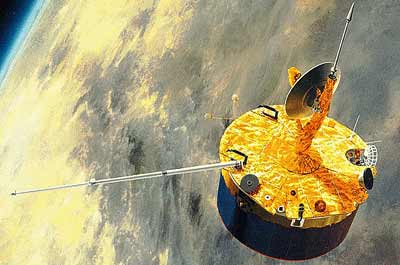Thank you very much for visiting Gunter's Space Page. I hope that this site is useful and informative for you.
If you appreciate the information provided on this site, please consider supporting my work by making a simple and secure donation via PayPal. Please help to run the website and keep everything free of charge. Thank you very much.
Pioneer 12 (Pioneer Venus Orbiter, PVO)

Pioneer 12 [Boeing BSS]
The Pioneer Venus Orbiter (PVO, Pioneer 12) was inserted into an elliptical orbit around Venus on 4 December 1978. The Orbiter was a flat cylinder 2.5 m in diameter and 1.2 m high. All instruments and spacecraft subsystems were mounted on the forward end of the cylinder, except the magnetometer, which was at the end of a 4.7 m boom. A solar array extended around the circumference of the cylinder. A 1.09 m despun dish antenna provided S and X-band communication with Earth.
The Pioneer Venus Orbiter carried 17 experiments (with a total mass of 45 kg):
- a cloud photopolarimeter to measure the vertical distribution of the clouds
- a surface radar mapper to determine topography and surface characteristics
- an infrared radiometer to measure IR emissions from the Venus atmosphere
- an airglow ultraviolet spectrometer to measure scattered and emitted UV light
- a neutral mass spectrometer to determine the composition of the upper atmosphere
- a solar wind plasma analyzer to measure properties of the solar wind
- a magnetometer to characterize the magnetic field at Venus
- an electric field detector to study the solar wind and its interactions
- an electron temperature probe to study the thermal properties of the ionosphere
- an ion mass spectrometer to characterize the ionospheric ion population
- a charged particle retarding potential analyzer to study ionospheric particles
- two radio science experiments to determine the gravity field of Venus
- a radio occultation experiment to characterize the atmosphere
- an atmospheric drag experiment to study the upper atmosphere
- a radio science atmospheric and solar wind turbulence experiment
- a gamma ray burst detector to record gamma ray burst events
From Venus orbit insertion to July 1980, periapsis was held between 142 and 253 km (at 17 degrees north latitude) to facilitate radar and ionospheric measurements. The spacecraft was in a 24 hour orbit with an apoapsis of 66,900 km. Thereafter, the periapsis was allowed to rise (to 2290 km at maximum) and then fall, to conserve fuel. In 1991 the Radar Mapper was reactivated to investigate previously inaccessible southern portions of the planet. In May 1992 Pioneer Venus began the final phase of its mission, in which the periapsis was held between 150 and 250 km until the fuel ran out and atmospheric entry destroyed the spacecraft the following August.
| Nation: | USA |
|---|---|
| Type / Application: | Venus orbiter |
| Operator: | NASA |
| Contractors: | Hughes |
| Equipment: | see above |
| Configuration: | HS-507 |
| Propulsion: | Star-24 |
| Power: | Solar cells (body mounted), batteries |
| Lifetime: | |
| Mass: | 517 kg |
| Orbit: | Heliocentric, later Venus orbit |
| Satellite | COSPAR | Date | LS | Launch Vehicle | Remarks | |
|---|---|---|---|---|---|---|
| Pioneer 12 (Pioneer-Venus 1, PVO) | 1978-051A | 20.05.1978 | CC LC-36A | Atlas-SLV3D Centaur-D1AR |
References:
- NSSDC Master Catalog: Pioneer Venus Orbiter
- Boeing: Pioneer Venus
